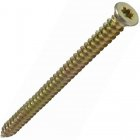
|
These Forgefix high-low thread Concrete Frame Screws are Zinc Yellow Passivated for increased resistance to corrosion. They offer a virtually stress free fixing, allowing close to edge applications. They are through-fixing, eliminating the need for marking and re-positioning when fixing batons etc. The Torx head of the screw enables increased torque control.
APPLICATION:
Extremely popular fixing for window and door frames. Also now used as a versatile fixing for many applications in DIY, Joinery, Plumbing and Electrical trades.
The Zinc Yellow Passivation process of electroplating is similar to the Galvanised and Zinc Plated processes but with the addition of a yellow dye. It offers an aesthetically pleasing finish, whilst having excellent resistance to corrosion.
By design, TORX head screws resist cam-out much better than Phillips or Slotted screws. Where Phillips heads were designed to cause the driver to cam out, to prevent over-tightening, TORX heads were designed to prevent it and to achieve a desired torque consistently. TORX head sizes are described using the capital letter T, followed by a number. A smaller number corresponds to a smaller point-to-point dimension of the screw head. Only the proper driver can drive a specific head size without risk of ruining the driver or screw.
High-Low Thread screws have an excellent holding power in wood due to their alternating high and low thread heights.
This is a review I found on the web (anon) which i thought was pretty good.
If you have never used these screws before you will wonder how you ever managed before without them.
They are the masonry equivalent of self tapping screws.
No more messing around drilling holes for raw plugs then messing around trying to poke the screw into them.
These screws cut their own thread into brick, concrete etc so no plugs are required.
All you need is a 6.5mm masonry drill bit.
Drill your hole straight through whatever your trying to attach and into the wall to the depth of your screw.
Then use an impact driver or drill to drive the screw in.
However, be careful not to over-tighten or you will destroy the thread the screw has cut into the wall.
|